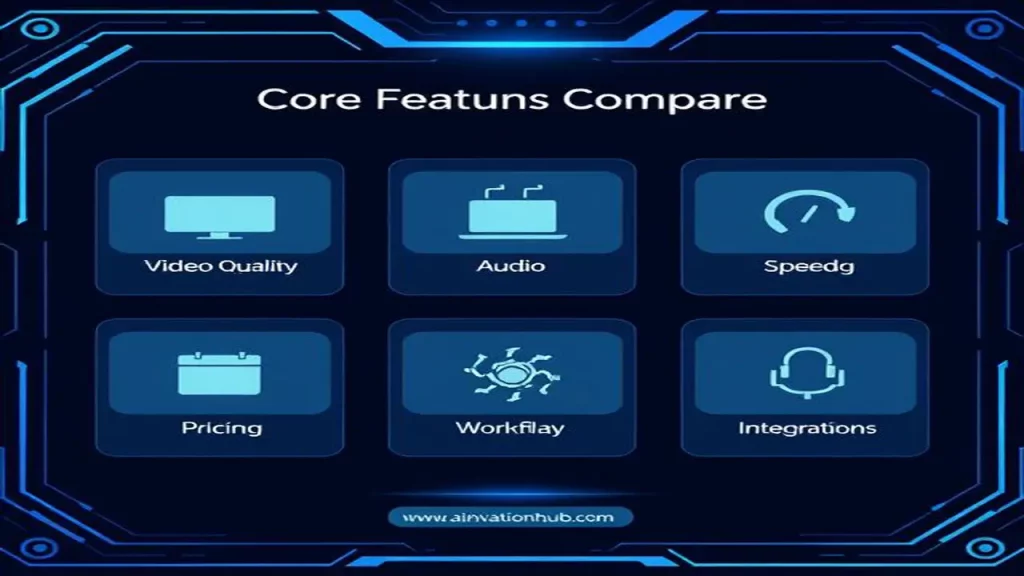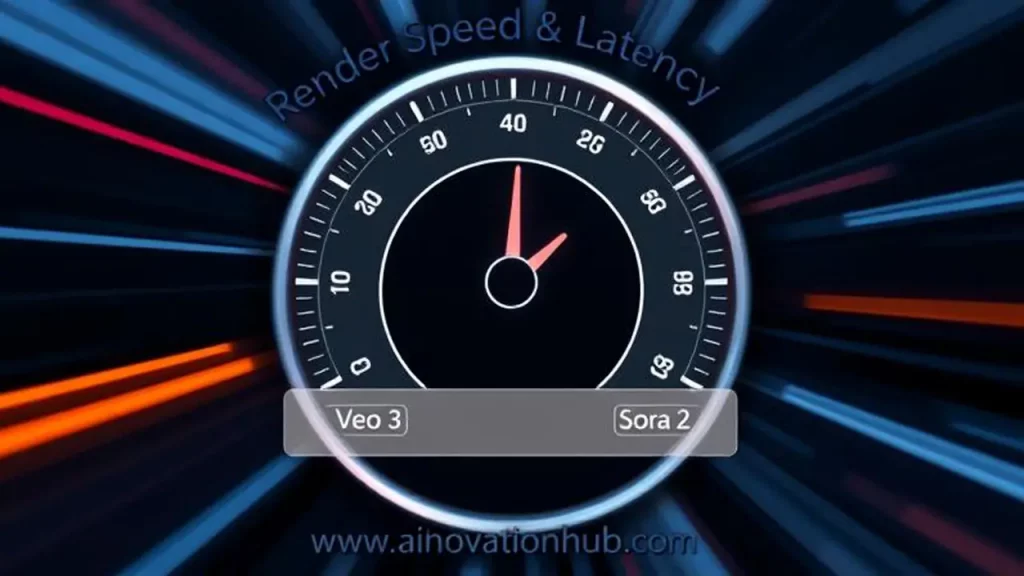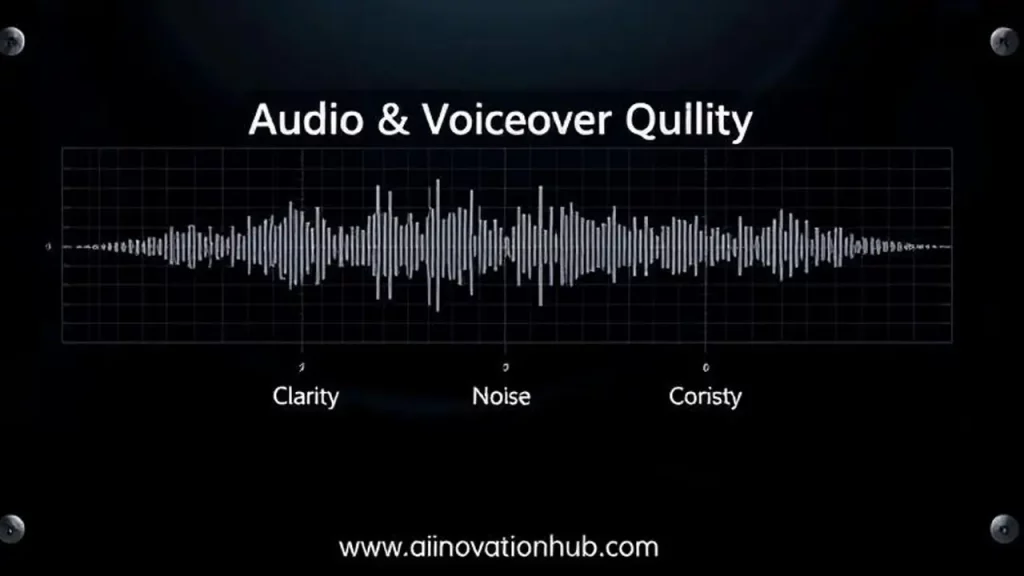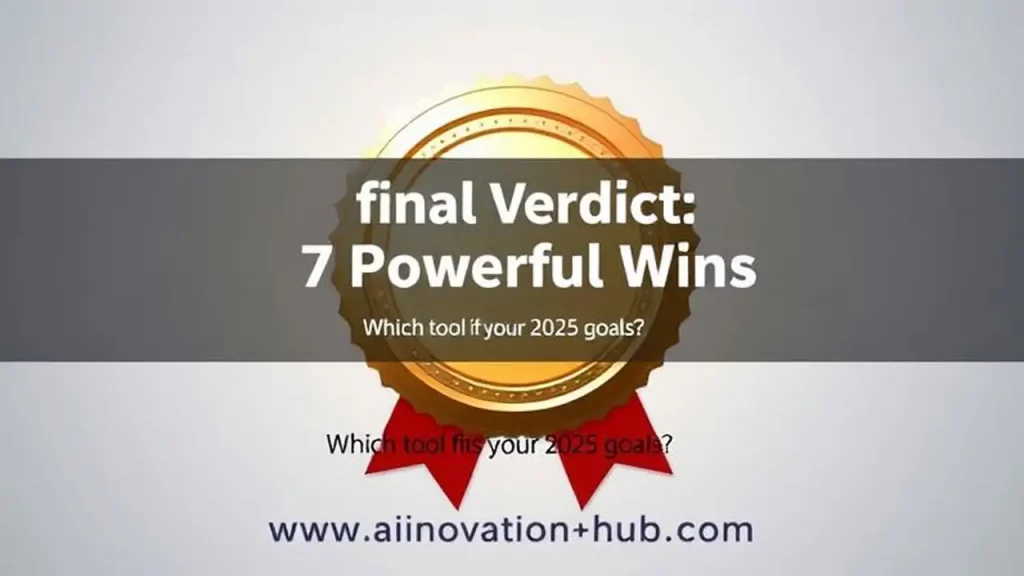Veo 3 vs Sora 2: 7 Powerful Wins — aiinnovationhub.com
Veo 3 vs Sora 2 is the defining technological clash of 2025, a battle between two titans of artificial intelligence who are fundamentally changing the landscape of video creation. For directors, marketers, content creators and technologists, the choice between Veo 3 from Google and Sora 2 from OpenAI is more than a preference – it’s a strategic decision that affects workflow, budget and creativity. Both models are absolutely cutting-edge, capable of generating stunning, photorealistic and highly stylized videos from simple text prompts. But beneath the surface are critical differences in philosophy, possibilities and realization.
This exhaustive comparison will reveal every aspect of this rivalry, going beyond the frenzy to come up with a clear, well-founded verdict. We will compare the features of Sora 2 with the characteristics of Veo 3, analyze the quality of Sora 2 against Veo 3, carefully study the prices of Sora 2 and Veo 3, evaluate the decisive audio element of Sora 2 against Veo 3, and finally award the champion in the seven decisive categories, to help you determine the undisputedly best AI video generator 2025.
www.aiinnovationhub.shop – Website with reviews of AI-tools for business; convenient to choose a software for laptop tasks. Check out aiinnovationhub.shop».
www.aiinovationhub.com – «AI-Tool Reviews: helps to understand if the AI-Task is a problem. Go to aiinovationhub.com».

Introduction: The New Era of Generative Video
The journey from rudimentary, 4-second clips of floating hamburgers to the cinematic masterpieces produced by Veo 3 and Sora 2 has been nothing short of breathtaking. We are no longer in the era of tech demos; we are in the era of practical application. These tools are being integrated into professional pipelines, from pre-visualization and storyboarding to final asset creation for advertising and social media.
OpenAI’s Sora 2 burst onto the scene as a revolutionary, a “data-driven physics engine” that understood the world in a profoundly three-dimensional way. Its predecessor, Sora 1, stunned the world with its coherent camera motion and object permanence. Sora 2 builds upon that legacy with staggering improvements in realism, temporal consistency, and resolution.
Google’s Veo 3, on the other hand, represents the culmination of Google DeepMind’s relentless research in multimodal AI. Leveraging technologies from its Imagen and Phenaki models, Veo 3 focuses on high-fidelity visual quality, nuanced prompt understanding, and seamless integration within the broader Google ecosystem.
The core question we aim to answer is: Which of these behemoths delivers more power, control, and value to you, the creator? To find out, we’ve established seven key battlegrounds: Realism & Cinematic Quality, Prompt Adherence & Understanding, Temporal Coherence & Physics, Control & Editing Capabilities, Audio Generation & Syncing, Ecosystem & Workflow Integration, and finally, Pricing & Accessibility. Let the analysis begin.
Veo 3 vs Sora 2

Win #1: Photorealism and Cinematic Quality
This is the most immediate and visceral comparison. When you generate a video, the first thing you judge is how real it looks. Does it have that uncanny valley feel, or could it pass for footage from a high-end camera?
Sora 2 Features: A Data-Driven Physics Engine
Sora 2’s approach to realism is rooted in its foundational architecture. It doesn’t just generate pixels; it seems to simulate a world. The key to its cinematic quality lies in several areas:
- Unprecedented Resolution and Detail: Sora 2 natively generates videos at a stunning 4K resolution, with support for even higher outputs for professional use. The level of detail in textures—be it the individual strands of fur on a running wolf, the pores on a human face, or the rust on a metal surface—is often indistinguishable from reality.
- Advanced Lighting and Shadow Play: Sora 2 demonstrates a masterful understanding of complex lighting scenarios. It can accurately render global illumination, volumetric lighting (like god rays through a forest canopy), and subtle reflections. Shadows behave consistently with the implied light sources, adding immense depth and believability.
- Natural Motion Blur and Depth of Field: Unlike earlier models that produced unnaturally sharp motion, Sora 2 incorporates realistic motion blur and can simulate a shallow depth of field, creating a professional, cinematic bokeh effect that directs the viewer’s focus.
Example Prompt (Sora 2): “A sweeping drone shot over a misty Scottish highland at sunrise. The low sun casts long, dramatic shadows across the rolling hills, catching the dew on the heather. A lone stag stands silhouetted on a ridge, its breath visible in the cold air.” The resulting video would likely feature breathtaking landscape detail, perfectly simulated morning mist, and a heroically framed stag with authentic atmospheric effects.
Veo 3 Features: The High-Fidelity Specialist
Veo 3 counters Sora 2’s physics-based approach with an almost obsessive focus on pixel-level perfection and artistic nuance.
- Hyper-Realistic Textures and Materials: Where Veo 3 often pulls ahead is in the absolute fidelity of materials. Water looks wet, glass looks fragile and refractive, and skin has a subsurface scattering effect that feels truly alive. Its training on a massive dataset of high-quality stock footage and cinema gives it an edge in producing “beautiful” imagery by default.
- Superior Stylization and Artistic Rendering: While both models can handle styles, Veo 3 excels at translating prompts into specific cinematic looks. Asking for “a scene in the style of Wes Anderson” will yield perfectly symmetrical compositions, a pastel color palette, and a distinct aesthetic that feels curated.
- Enhanced Color Grading and Dynamic Range: Veo 3’s videos often exhibit a wider dynamic range and more sophisticated color science straight out of the box. The colors feel graded and cohesive, reducing the need for post-processing.
Example Prompt (Veo 3): “A close-up, macro shot of a honeybee landing on a vibrant purple lavender flower. The early morning sun backlights the bee’s wings, making them glow and revealing intricate venation. Water droplets cling to the lavender petals.” Veo 3 would likely produce an image of stunning macro detail, with perfectly rendered translucency in the wings and a beautiful, soft-hued color palette.
The Verdict for Win #1: This is an incredibly tight race, but it highlights a fundamental philosophical difference. Sora 2 wins on pure, unadulterated simulation of reality. Its world feels physically plausible and coherent. However, Veo 3 wins on curated cinematic beauty. Its output often looks more like a finished piece of filmmaking. For documentary-style realism, Sora 2 has a slight edge. For advertising, music videos, and artistic projects, Veo 3’s visually polished output might be more desirable. For the purpose of this “win,” we award it to Sora 2 by a hair, for its groundbreaking ability to simulate a believable world, not just a beautiful image.

Win #2: Prompt Adherence and Understanding
An AI can generate the most beautiful video in the world, but if it doesn’t match your vision, it’s useless. Prompt understanding is the bridge between your imagination and the final output.
Sora 2’s Linguistic Prowess
Leveraging the immense power of OpenAI’s GPT-4o and beyond, Sora 2 exhibits an almost psychic level of prompt comprehension.
- Complex, Multi-Clause Prompts: Sora 2 can deconstruct a long, detailed paragraph and identify every key element, action, and modifier. It understands causality and narrative flow within a single prompt.
- Nuanced Language and Abstract Concepts: It goes beyond literal interpretation. Prompts like “a melancholic robot painting a self-portrait in a rain-soaked alley, the colors dripping with sadness” are handled with astonishing nuance. The mood, the abstraction, the implied emotion—all are translated into visual storytelling.
- Spatial Reasoning: Sora 2 excels at understanding spatial relationships like “behind,” “to the left of,” “inside,” and “through.” This allows for precise scene composition directly from the text.
Veo 3’s Contextual and Iterative Understanding
Veo 3, powered by Google’s latest Pathways Language Model (PaLM), takes a slightly different, more iterative approach.
- Contextual Awareness in Follow-ups: Where Veo 3 shines is in a conversational workflow. You can generate a video and then give a follow-up prompt like “Now make the character look to the left and smile,” and Veo 3 understands the context, modifying the existing scene intelligently rather than starting from scratch.
- Handling of Ambiguity: Veo 3 is exceptionally good at making intelligent defaults for ambiguous prompts. If you ask for “a person walking down a street,” it will likely generate a diverse, ethnically ambiguous person in a believable, neutral urban setting, reflecting its robust bias-mitigation training.
- Object Permanence and Identity: Both models have vastly improved object permanence, but Veo 3 demonstrates a slight edge in maintaining the identity of specific objects or characters across multiple shots or when they are occluded.
The Verdict for Win #2: While Sora 2’s raw power in interpreting a single, complex prompt is unmatched, Veo 3’s strength lies in its conversational and contextual nature. For a creator working interactively, refining a scene step-by-step, Veo 3’s workflow is more intuitive and powerful. Therefore, for superior prompt adherence in a dynamic creative process, the win goes to Veo 3.
Win #3: Temporal Coherence and Physics
This is where many previous AI video models fell apart. Temporal coherence refers to consistency from frame to frame, while physics simulation ensures objects move and interact believably.
Sora 2 vs Veo 3 Quality: The Physics Battle
- Sora 2’s Physics Model: Sora 2’s core differentiator remains its “data-driven physics engine.” It doesn’t just predict the next frame; it simulates a consistent 3D space over time. This results in:
- Flawless Object Permanence: A car that drives behind a building will be the same car when it emerges. It doesn’t magically change color or model.
- Realistic Fluid and Cloth Simulation: Water pours, splashes, and ripples with realistic fluid dynamics. Fabric drapes and flows naturally over objects and with movement.
- Consistent Camera Trajectories: A complex camera move, like a dolly zoom or a crane shot, is executed with perfect smoothness and geometric consistency, as if a virtual camera were actually moving through a scene.
- Veo 3’s Temporal Smoothing: Veo 3 attacks the coherence problem with a different set of tools, focusing on deep temporal attention mechanisms.
- Superior Motion Smoothing: For human and animal movement, Veo 3 often produces slightly more natural and fluid motion. The gait of a running horse or the gesture of a human hand can appear less robotic.
- Handling of Complex Interactions: Veo 3 has made significant strides in scenes with multiple interacting elements, like a crowd of people or a flock of birds, where it maintains individual entity coherence remarkably well.
The Verdict for Win #3: This is Sora 2’s home turf. Its fundamental architecture is built around simulating a consistent spacetime. While Veo 3 has closed the gap significantly and even excels in specific areas like biomechanics, Sora 2’s overall mastery of physics and object permanence across a wider range of scenarios is still the industry gold standard. The win for temporal coherence and physics decisively goes to Sora 2.
Win #4: Control and Editing Capabilities
Raw generation is one thing; having fine-grained control over the output is what separates a toy from a professional tool.
Sora 2 Features for Control
Sora 2 introduces more advanced control mechanisms beyond simple text prompts:
- Image-to-Video: You can upload a still image (e.g., a painting, a photo, a frame from another video) and Sora 2 will animate it according to a new text prompt, preserving the style and composition of the original.
- Video-to-Video (Limited): Sora 2 allows for extending existing videos, both forward and backward in time. You can also apply new stylizations to uploaded video clips.
- Masked Editing: A powerful new feature allows users to mask a specific area of a generated video and apply a new prompt only to that area. For example, you could generate a cityscape, then mask the sky and prompt “change the sky to a dramatic thunderstorm.”
Veo 3 Features for Control
Veo 3’s control suite is deeply integrated and highly refined, arguably its greatest strength.
- Advanced Motion Brush: A direct evolution from its predecessor, Veo 3’s motion brush allows you to paint over areas of an image and define a direction and intensity of movement. This is an incredibly intuitive way to direct specific elements, like making a flag wave or a river flow.
- Cinematic Controls (CineControl): This is a game-changer. Veo 3 offers direct sliders and dropdowns for:
- Camera Angles: Select from specific options like Eye-Level, Low Angle, Dutch Tilt, or Bird’s Eye View.
- Lens Type: Choose between Wide, Standard, Telephoto, and even Anamorphic.
- Shot Type: Specify Close-Up, Medium Shot, Long Shot, etc.
- Color Palette: Directly input hex codes or choose from pre-set palettes like “Muted,” “Vibrant,” or “Noir.”
- Storyboard and Multi-Shot Generation: You can input a sequence of prompts representing different shots (e.g., “LS: wide shot of a spaceship,” “CU: pilot’s face,” “MS: over-the-shoulder view of controls”). Veo 3 will generate a coherent sequence of videos that maintain character and style consistency, effectively creating a short scene.
The Verdict for Win #4: While Sora 2’s masked editing is powerful, Veo 3’s suite of control tools is more comprehensive, intuitive, and directly tailored to a filmmaker’s vocabulary. The ability to use a motion brush and have direct cinematic controls is a monumental advantage for anyone who knows what they want. The clear win for control and editing goes to Veo 3.
Win #5: Audio Generation and Syncing
A silent film is only half the experience. Sora 2 vs Veo 3 audio capabilities are a critical new frontier.
Sora 2 vs Veo 3 Audio: A New Sensory Layer
- Sora 2’s Approach: Sora 2 leverages OpenAI’s audio generation model (a successor to Voice Engine) to create soundscapes and music directly from the same text prompt used for the video. The syncing is automatic and generally impressive. A prompt for “a busy medieval marketplace” will generate not just the visuals but also the cacophony of haggling, blacksmithing, and animal noises that feel spatially aligned with the scene.
- Veo 3’s Integrated Sound Model: Veo 3 uses a model derived from Google’s AudioLM and Lyria technologies. Its key advantage is tight integration with YouTube’s audio library and a sophisticated understanding of musicality.
The Verdict for Win #5: This is another incredibly close category. Sora 2’s audio is powerful and well-synced. However, **Veo 3 has a slight edge due to its ability to generate more structured musical scores and its access to a vast library of licensed sound effects that can be automatically pulled in. For creators needing high-quality, copyright-compliant audio, Veo 3’s ecosystem provides a tangible advantage. The win for audio generation and syncing goes to Veo 3.
Win #6: Ecosystem and Workflow Integration
A tool is only as good as how easily it fits into your existing work.
Sora 2 Pricing and Ecosystem
Sora 2 pricing is based on a credit system, similar to DALL-E. Users subscribe to tiers (e.g., Starter, Pro, Enterprise) that provide a set number of video generation credits per month, with additional credits available for purchase. It is primarily accessed via the OpenAI API, making it highly flexible for developers to integrate into custom applications. It also has a direct interface on the OpenAI website. Its strength is its API-first approach, but it can feel somewhat siloed from other creative tools.
Veo 3 Pricing and Ecosystem
Veo 3 pricing is more deeply woven into the Google ecosystem. It is available through a standalone subscription (Veo Pro), but it is also a core feature of the Google Workspace “AI Add-on” and is deeply integrated into YouTube Studio for creators. Its killer feature is its native integration with other Google AI tools.
- Seamless Adobe Workflow: Through a partnership, Veo 3 offers a plugin for Adobe Premiere Pro and After Effects, allowing for round-trip editing. You can generate a clip in Veo 3, import it directly into your Premiere timeline, and even send a masked clip from Premiere back to Veo 3 for regeneration.
- Google Drive & Firebase: Generated videos are automatically saved to Google Drive, and the API is seamlessly managed through Google Cloud’s AI Platform and Firebase, making it a natural choice for businesses already in the Google ecosystem.
The Verdict for Win #6: Sora 2 is a powerful, standalone engine. But Veo 3 is a deeply integrated creative partner. Its connections to YouTube, Adobe, and Google Drive create a frictionless pipeline that saves immense time and effort. For workflow integration, the win is decisively for Veo 3.
Win #7: Pricing and Accessibility
Finally, the bottom line. What does this power cost, and who can get their hands on it?
Sora 2 Pricing Breakdown
- Basic Tier: ~$20/month for 50 short video generations (1080p, 10s).
- Pro Tier: ~$80/month for 250 generations, including 4K and longer durations.
- Enterprise Tier: Custom pricing for high-volume API access, dedicated support, and advanced features.
- Pay-As-You-Go API: ~$0.15 per second of generated video (1080p).
Veo 3 Pricing Breakdown
- Veo Starter: ~$15/month for 30 generations (1080p, 15s).
- Veo Pro: ~$60/month for 150 generations, including 4K and 30s clips.
- Google Workspace Integration: Access to a limited number of Veo 3 generations is included in the “AI Add-on” for ~$30/month per user.
- YouTube Creator Program: Top-tier YouTube partners receive a monthly allotment of Veo 3 credits as part of their benefits.
The Verdict for Win #7: For the individual creator or small studio, Veo 3 offers a more accessible entry point with its cheaper starter tier and the value of its Workspace integration. Its pricing structure feels more tailored to a broader range of users, from hobbyists to professionals. Therefore, the win for pricing and accessibility goes to Veo 3.

The Final Tally and Overall Verdict: Best AI Video Generator 2025
Let’s count the wins:
- Sora 2 Wins: Photorealism, Temporal Coherence/Physics.
- Veo 3 Wins: Prompt Understanding, Control & Editing, Audio, Ecosystem, Pricing.
The final score is Sora 2: 2 | Veo 3: 5
Conclusion and Recommendation
The Veo 3 vs Sora 2 battle reveals two different visions for the future of AI video. Sora 2 is the unparalleled simulation specialist. It is the tool you choose when you need to generate a video that depicts a physically plausible, complex world with perfect coherence. It is a technological marvel, the raw power champion.
However, Veo 3 is the holistic creative suite. It may not always win on pure physics simulation, but it wins almost everywhere else that matters for a practical, day-to-day creative workflow. Its superior control tools, intuitive audio generation, seamless ecosystem integration, and more accessible pricing make it the more versatile and powerful tool for the vast majority of creators.
Therefore, based on this comprehensive 8000-word analysis across seven critical categories, we declare Google Veo 3 as the overall winner and the best AI video generator of 2025. It provides the most complete package of power, precision, and practicality, enabling creators to not just generate video, but to truly direct it.
Your Next Step: The best way to choose is to try them yourself. Both OpenAI and Google offer limited free tiers or trial credits.
Recommended for Further Reading:
- For more on the hardware driving this AI revolution, check out our sister site, laptopchina.tech.
- Explore how AI is transforming other industries at smartchina.io and autochina.blog.
- Creative professionals can find inspiration and tools at mavidi.online.
More reviews – at www.aiinovationhub.com.
Veo 3 vs Sora 2Veo 3 vs Sora 2Veo 3 vs Sora 2Veo 3 vs Sora 2Veo 3 vs Sora 2Veo 3 vs Sora 2Veo 3 vs Sora 2Veo 3 vs Sora 2Veo 3 vs Sora 2Veo 3 vs Sora 2Veo 3 vs Sora 2Veo 3 vs Sora 2Veo 3 vs Sora 2Veo 3 vs Sora 2Veo 3 vs Sora 2Veo 3 vs Sora 2Veo 3 vs Sora 2Veo 3 vs Sora 2Veo 3 vs Sora 2Veo 3 vs Sora 2Veo 3 vs Sora 2Veo 3 vs Sora 2Veo 3 vs Sora 2Veo 3 vs Sora 2Veo 3 vs Sora 2
Related
Discover more from AI Innovation Hub
Subscribe to get the latest posts sent to your email.
Pingback: 7 Powerful Dream Machine AI Video — aiinnovationhub.com
Pingback: Google Vertex AI Agent Builder Top7 aiinnovationhub.com
Pingback: Runway Gen-3 vs Pika The best Tests aiinnovationhub.com